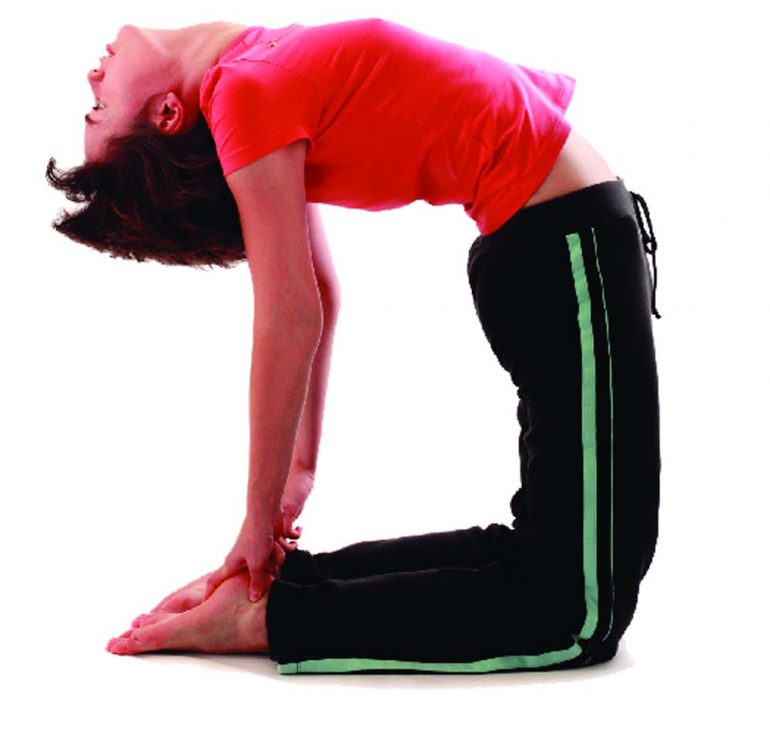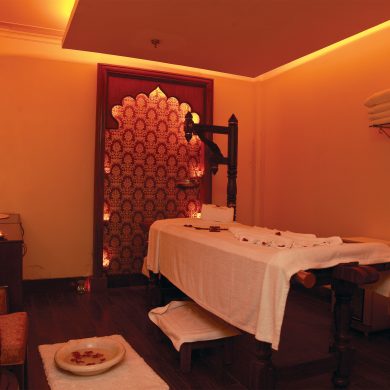Q: I have Type 1 diabetes, and I want to reduce the units of insulin that I take every day. Can yoga help?
Tushar Mundra
A: Yoga can be very beneficial in the treatment of Type 1 diabetes. In the practice of yoga, due to the various twists, stretches and strains in the body, the internal organs experience an increase in the oxygen supply to the organs, thus increasing the efficiency and functioning of the pancreas and endocrine glands. Asanas like Dhanurasana (Bow Pose), Ardhamatsyendrasana (Half-spinal Twist) are beneficial to the liver, kidneys and the adrenal glands; Vajrasana (Thunderbolt Pose), Pavan Muktasana (Wind relieving Pose), Sarvangasana (Shoulder Stand),Halasana (Plough Pose) and Matsyasana (Fish Pose) have also been found useful in diabetes. These asanas have a positive effect on the pancreas and insulin functioning. Among others are the backward bending postures such as the Bhujangasana (Cobra Pose), Salabhasana (Locust Pose), Poorna Salabhasana (Full Locust Pose) and Ustrasana (Camel Pose). In addition, most of these postures cause the internal viscera to stretch, bringing stimulation to the pancreas and other glands and organs that otherwise receive no stimulation. Other postures such as Ardha Kurmasana (Half Tortoise Pose), Sasangasana (Rabbit Pose), Janushirasana (Head to Knee Pose) and Paschimotanasana (Posterior Stretch) provide stimulation and rejuvenation to the cells of the pancreas and other endocrine glands by way of compression. Compression of these glands, followed by relaxation, causes an increased volume of highly oxygenated blood to reach the cells, bringing nourishment that rejuvenates the atrophied cells.
Among Pranayama, Alternate Nostril Breathing is useful in diabetes, as it has a calming effect on the nervous system, which reduces stress levels and helps in diabetes treatment.
Brahmari Pranayama and Bhastrika Pranayama are also very helpful. You may add affirmations in the entire yoga practice of meditation, Pranayama, asanas and Yoga Nidra. Yoga Nidra is a very important process of deep relaxation; it helps alleviate stress and has very good positive effects on the entire body-mind complex.
Q: I am a 27-year-old woman who has suffered from migraine and chronic headaches since the age of 20. I have tried all types of medication and it has failed. Can Ayurvedic medicine help me? Can yoga help me?
Tina Paul
A: Yoga helps through the realization that the answer to all the ailments of the body and mind are the body and mind itself. It helps by regaining balance and harmony in the mind-body relationship. Headaches and migraines may be due to physical and mental stress, poor vision, bad posture, etc. A regular practice of Pranayama (including Anulom Vilom) can be very useful in relieving headaches. I would also suggest an eye check up and a visit to the primary physician to rule out any other underlying causes. Apart from the breathing exercises, a regular yoga practice along with a meditation regime will also help in posture improvement and building up of strength in the neck and shoulders.
Q: Can you share your thoughts on yoga for people with Marfan syndrome?
Linda B.
A: Marfan syndrome is generally a combination of complications with the heart and blood vessels, mitral valve prolapse (MVP), including leaky valves and an enlarged aorta, chest wall deformities (indented or protruding breastbone), curved spine (scoliosis, kyphosis, lordosis). The eyes (nearsightedness), lungs (poor lung capacity) and skin may also be affected.
Early diagnosis and treatment, combined with lifestyle changes, can limit and prevent complications, lengthen life and improve the quality of life. In general, low impact exercises can help improve physical strength and endurance, increase bone density and lower the blood pressure. However, activities that are more strenuous may be dangerous, increasing the risk of damage to your aorta, eyes and ligaments.
I would suggest a very simple and mild yoga series. It should typically be through a private yoga session or a special yoga therapy class. Simple eye exercises, joint range of motion movements, neck exercises and very simple yoga postures with emphasis on smooth and slow movements (poses that initially do not require too much strength, but the ones which focus on de-stressing, stretching and calming down) may be preferred. I would suggest Balasana (Child’s Pose), Janushirasana, Ardha Chandrasana (Half moon Stretch), Baddha Konasana (Cobbler’s Pose/Bound angle Pose), Pavan Muktasana (Wind relieving Pose), Viparita Karni (Simpleinverted Pose) and Shavasana (Corpse Pose) to name a few.
Apan Vayu mudra is an alternative way to deal with complications of the heart and blood vessels. A regular practice of this mudra (three times a day for 5-15 minutes in each practice) should be done as therapy.
Benefits of Apan Vayu Mudra:
a) Regular practice of this mudra helps prevent heart attacks and their recurrence.
b) It is an antidote to a heart attack and acts like a savior. This is the reason it is called Mritsanjeevani mudra, “one which brings back life out of death.”
c) It also helps in cases of palpitation, depression, slow heart beat, angina, etc.
Q: I suffer from regular backaches, and my husband is suffering from a cervical problem. Please advise.
Vandana Sharma
A: Backaches and cervical problems are indicative of one of the following issues (or a combination of these): weak back muscles, poor posture, poor core strength, stress, and lack of exercise or an excessive exercise regimen. Every backache is different due to its root cause. I would suggest that both of you practice yoga therapy with caution. Forward bending poses are recommended. A combination of Pranayama Kapalbhatti to build core strength, Anulom Vilom to release stress; asanas – Bhujangasana to neutralize poor upper back posture and strengthen the upper back, shoulders and neck, Naukasana to strengthen the middle back, and Salabhasana to build lower back strength, are recommended.
If you have any yoga related health queries, please email us at YogaHelpline@TathaastuMag.com.
Q: I am a patient of hypothyroidism since 1996. Are there any Ayurvedic medicines and exercises in yoga which may help? Also, is there any Ayurvedic medicine for helping a person quit smoking and drinking? I shall be grateful if you could suggest some remedies.
Ashish
A: Thyroid is one of the master glands in the human body. The malfunctioning of this gland puts the entire hormonal system out of balance. Many yogasanas, Pranayama and mudras can help boost this gland and optimize its secretion of hormones.
Asanas: Sarvangasana (Shoulder Stand), Matsyasana (Fish pose), Setubandhasana (Bridge pose), Paschimottanasana (Forward Bending pose) and Halasana (Plough pose).
Pranayama: Ujjayi Pranayama – Inhale maximum to the lung capacity through both the nostrils, keeping the glottis partially closed. This makes a faint sobbing sound as if you are breathing from the throat. Retain the breath applying the Vishnu mudra and then exhale from the left nostril/ right nostril. Stretch your inhalation and exhalation as much as you can without generating tension anywhere in your body, and let the sound of the breath be smooth and unbroken.
Mudras: Simha mudra, Shankh mudra, Brahma mudra.
For Ayurvedic remedies please refer to Ayurveda Helpline in this issue.
Q: I have been severely affected by constipation, bloating, and heaviness in my body. Could you please give your expert advice on this? I have done yoga only once or twice in my lifetime. I am 26 years old and work in the IT industry. Any help will be greatly appreciated.
Tammy M, Ohio
A: These problems, as shared by you, are becoming more common these days due to job-related stress, irregular lifestyle and unhealthy eating habits. A regular practice of postures, breathing and meditation creates an inclination towards healthy habits, which arises from within.
I recommend you join a regular yoga therapy class. I also suggest the following practice:
Duration: 60 minutes; Time: Morning or Evening; Prerequisite: Empty stomach
Kriya: Kapalbhati (5 minutes), Nauli (2 minutes)
Meditation (5-10 minutes): Chanting OM 11 times audibly and meditation on breath for five minutes. Keep the hands in Apaan Vayu mudra as you meditate.
Pranayama: Nadi Shodhan Pranayama (5 minutes without restraining the breath).
Apaan Vayu Mudra
Asanas (30 minutes): Six rounds of Sun Salutations. Followed by sitting, prone and supine postures like Paschimottanasana (Forward bending pose), Poorvattanasana (Inclined Plane), Ardha Matsyendrasana (Half Spinal Twist), Naukasana (Boat pose), Sarvangasana (Shoulder Stand), Halasana (Plough pose), Pavanmuktasana (Wind relieving pose), Balasana (Child pose), Dhanurasana (Bow pose), Trikonasana (Triangle pose).
Shavasana: Relaxation asana for ten minutes.
Q: Is there a mudra for relieving joint pain and aches? I have been following your suggestions from the very first issue of Tathaastu and I love your column on Home Remedies as well.
Alison, NY
A: There is a mudra for relieving joint pain and aches. It is a mudra to be done with both hands. To practice this mudra, you hold the right hand in Prithvi mudra (earth element) and the left hand in Akash mudra (ether element). As the name suggests this brings a balance of earth and ether elements in the body, which are present in the joints, bones and muscles. This mudra should be practiced thrice daily (morning, afternoon and evening), before breakfast, lunch and dinner for at least two minutes in each practice session. Slowly increase the time to five minutes in each practice session.
Q: I am 75 years old. I have problems of hypertension, high cholesterol, asthma and obesity. I was on blood pressure- and cholesterol-lowering medication. I also took pills for my asthma. I was so tired and distressed that one night I decided to stop all medication. I started doing yoga. I drink half a glass of warm milk with turmeric powder in the morning and evening. I also do meditation and eat a light diet. I am feeling better now and am able to sleep. Blood pressure levels are also under control. I still have asthma and cannot do Pranayama properly. Please advise Ayurvedic remedies, home remedies and yoga poses.
A: It gives me immense satisfaction that you are feeling so much better by taking the alternative remedies route. For asthma, I would suggest postures that are chest openers, warming and relaxing, and ones that encourage lymphatic drainage.
Some of these postures are: Bhujangasana (Cobra pose), Poorvattanasana (Inclined Plane), Ustrasana (Camel pose), Dhanurasana (Bow pose), Chakrasana (Wheel pose). A regular practice of Pranayama like Bhastrika and Anulom Vilom will help to increase the lung capacity. I recommend you avoid restraining/holding of breath in any Pranayama. Practice the Pranayama session twice daily, preferably morning and evening for fifteen minutes in each session.
Ling mudra would be of special benefit to release the bronchial congestion and break the phlegm. To practice this mudra, interlace the fingers of both hands in a way that the little finger of the left hand is at the bottom and the thumb of the left hand is raised up and embraced by the index finger and thumb of the right hand. Make a tight grip and hold this mudra for two to three minutes. Do this mudra once or twice daily. At times, due to excessive heat in the system, if you feel nauseous or dizzy – you must release the mudra and try again later.
For Ayurvedic remedies please refer to Ayurveda Helpline in this issue.
If you have any yoga-related health queries, please email us at YogaHelpline@TathaastuMag.com.







